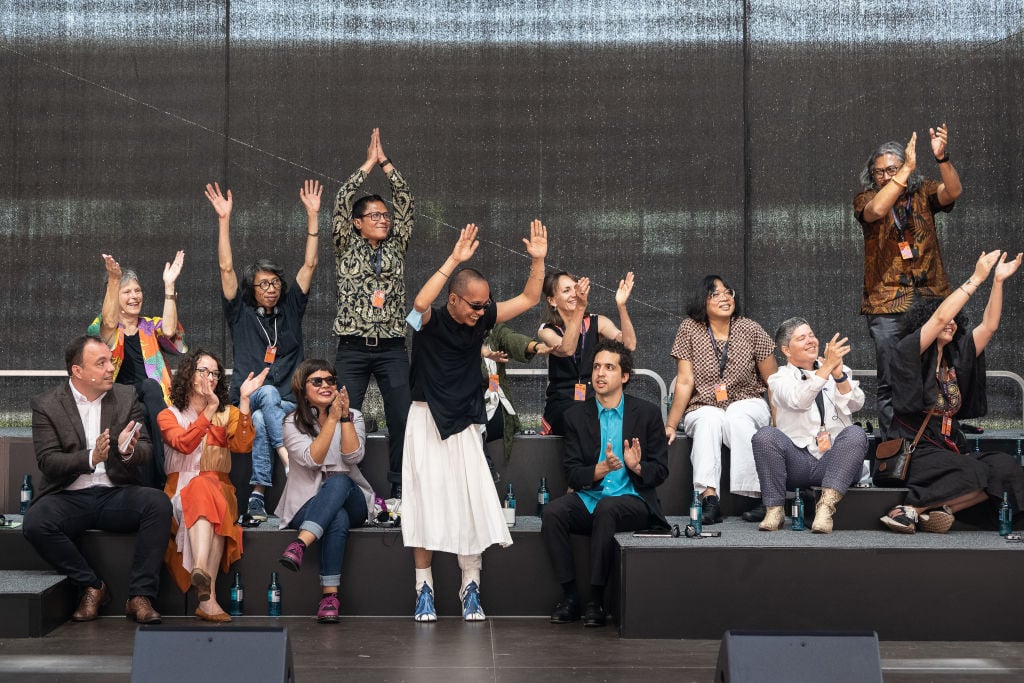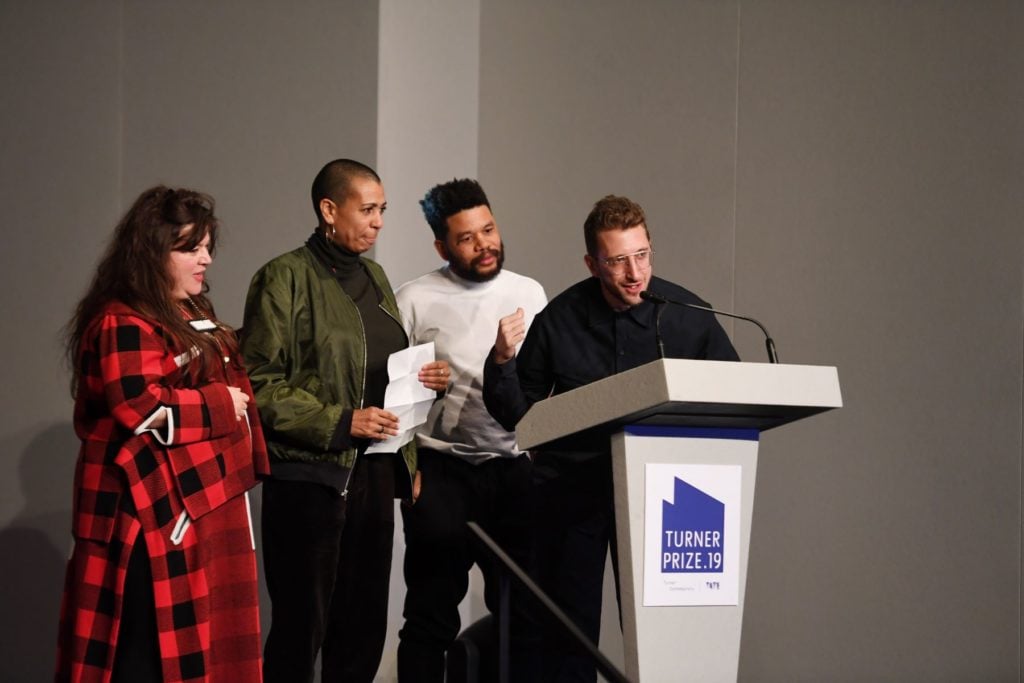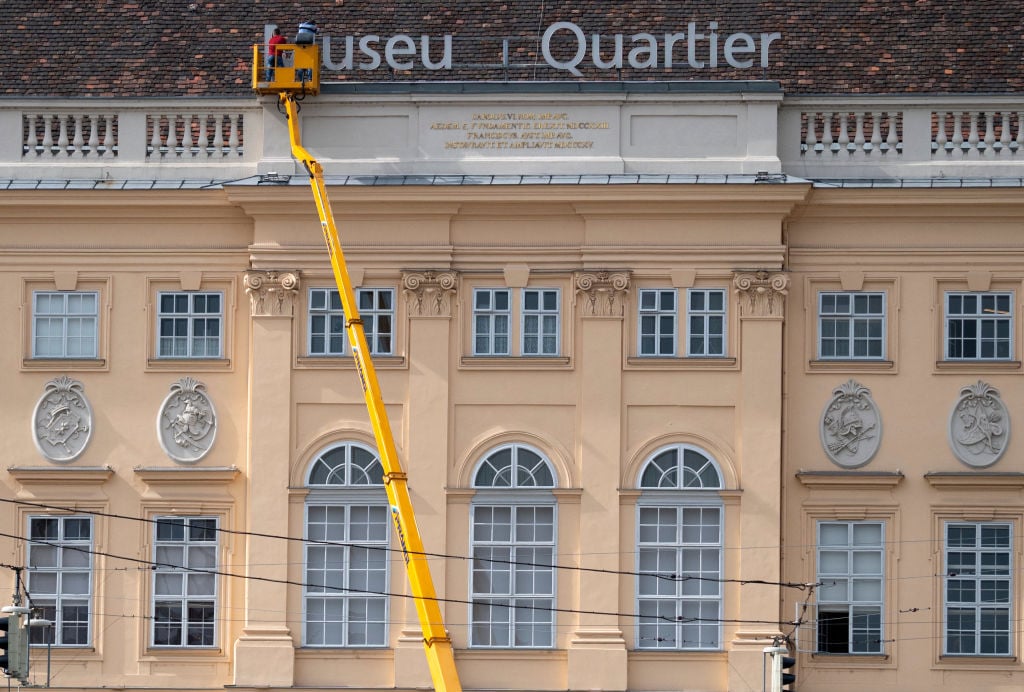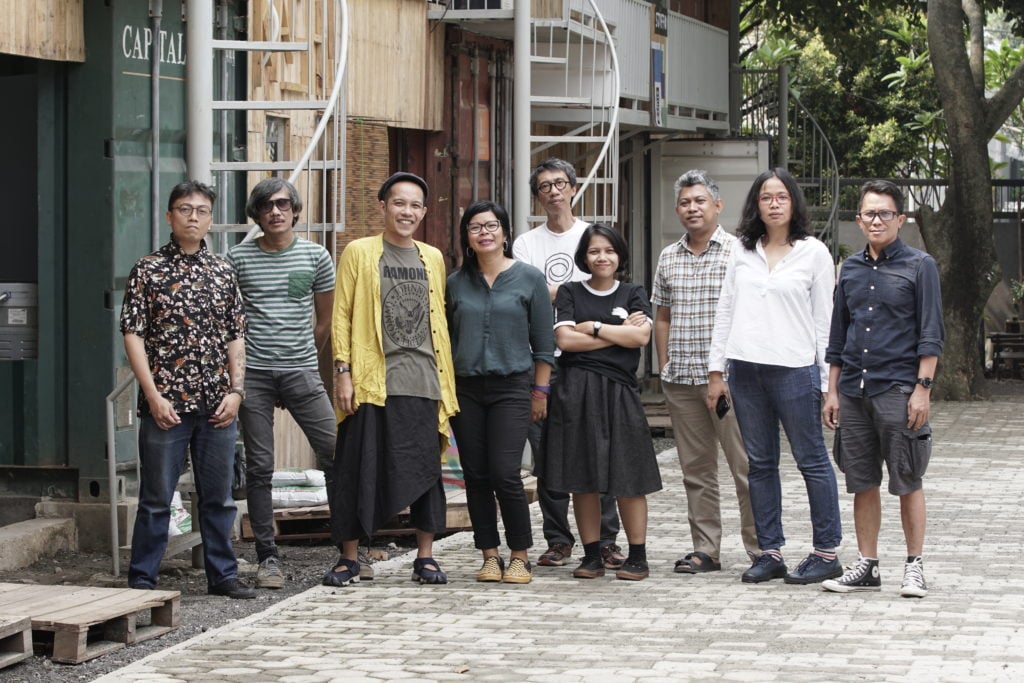Opinion
Art Collectives Were the Talk of the Art World in the Last Few Years. Has Their Moment Passed?
As soon as collective action became a “trend,” it was always at risk of going out of fashion.

As soon as collective action became a “trend,” it was always at risk of going out of fashion.

Kate Brown

Artist collectives are by no means new phenomena. Still, their presence in the art world has been largely fringe, only rarely intersecting with mainstream notions of commercial success and celebrity clout. Recently, however, as museums in particular came under pressure to address social change, ideas like “collective action” and “mutual aid” have seized the spotlight.
For a moment it seemed as if the notion of cooperation might outbid competition in the art world. Suddenly, collectives were among the art world’s ascendant stars. The question is if this moment is now over.
A series of notable institutional appointments marked the end of the last decade, and seemed to signify an end—or at least a re-thinking—of art-world individualism. In 2019, Indonesian art collective Ruangrupa was named to head up the prestigious German exhibition Documenta, seemingly touching off a new era. Their concept? To base their show on collective creativity from the Global South, creating “a collective of collectives.”
That same year, the Turner Prize shortlisted four individual artists who decided to meld into a flash art collective for the purposes of accepting the esteemed prize, flying in the face of the art-world winner-take-all premise. How outdated and selfish individual prize winners suddenly seemed.
Naturally, as a next step, only collectives were shortlisted in the subsequent edition of the Turner Prize, in 2021. Canada’s own version of the Turner, the Sobey Art award, declared that same year that the two dozen artists shortlisted were all winners. The cash was distributed among them. In the face of financial hardships aggravated by the pandemic, individualism was out, collaboration was in.

Tai Shani, Helen Cammock, Oscar Murillo and Lawrence Abu Hamdan celebrate after being announced as the joint winners of Turner Prize 2019. Photo by Stuart C. Wilson/Stuart Wilson/Getty Images for Turner Contemporary.
That same tipping-point year, 2019, was also the year that the collective WHW from Zagreb, Croatia, was nominated to head the Kunsthalle in Vienna, a prestigious contemporary art museum nestled in the resplendent Museum Quarter in the Austrian capital. It was the first appointment of its kind to such an established institution, and it seemed to cap off this new cultural wave. The three curators, Nataša Ilić, Ivet Ćurlin, and Sabina Sabolović, would share two salaries three ways; they would be reachable at one email address.
By 2021, the sentiment of collective action truly entering the mainstream was also hitting the art market canon as well, largely by way of collective buying attempts. ConstitutionDAO, a failed exercise by a crypto-powered “decentralized autonomous organization” to buy an original copy of the U.S. constitution from Sotheby’s, saw micro investors sweep into a blue-chip auction.
Crypto is more associated now with cynicism than idealism—but you must recall that the crypto boom came in the wake of the Gamestop affair, with its rhetoric of taking on Wall Street for the small investor; ConstitutionDAO was all about returning the art market “to the people.”
Ruangrupa’s Documenta incorporated multiple crypto initiatives, including a scheme to use crypto to build an alternative economy from the Palestinian collective The Question of Funding. The vogue for artist collectives was not just old-fashioned anti-market purity, but arose from practical concerns with a pragmatic focus, proposing new, shared ways of surviving.

Museums Quarter is home to the Kunsthalle Vienna. (Photo by Joe Klamar/AFP via Getty Images)
Dreams of collectivity in the financialized and non-financialized zones of the art world have deep roots. They tend to surge forward in moments of widespread crisis, as they did post World War 2 and again in the throes of Occupy Wall Street, post 2008 meltdown. But they were usually outside the door of the art world center, banging to get in. What’s different about the most recent period is that it really felt as if this door had been opened.
The longer history of collectives and collective politics were at play here: WHW are named in reference to a Marxist idea of “what, how, and for whom,” while Ruangrupa brought forward their socialist-inflected lumbung concept. Both were founded one year apart, in 2000 and 1999, respectively. It took two decades and various kinds of social upheaval in the wider world, but the time for these ideas to take charge seemed at hand.
It was no longer about just exhibiting collectives like the Guerrilla Girls or Superflex (although, in keeping with the zeitgeist, data shows that the Guerrilla Girls were one of the most collected artists in this period, and Superflex one of the most-shown at biennials), but about integrating collective ways of work into the bureaucratic strata of institutions, changing how they functioned at the deepest structure.
Ruangrupa’s expansive vision, the discussion around the Turner Prize, and WHW’s appointment all signaled a deep desire to flatten hierarchies. How much could such top-down cultural institutions truly mirror this method?
Maybe they couldn’t. Maybe they never truly wanted to.

Message on the landing page of the ConstitutionDAO during the sale.
There are signs that the moment, however profound it seems, has passed.
Last December, after four years, WHW was ousted from their job. The reasoning given was wooly at best—the collective called the motivations “unclear and unfair.” The Croatian collective re-applied, and were denied. Kunsthalle board member Boris Marte resigned in protest of the decision—but no matter: WHW will be gone from the Kunsthalle in June 2024.
Their program, which was focused on highlighting overlooked narratives in Eastern European, de-colonialist, and feminist themes, was generally well-received. There were no major controversies. If their attendance numbers were the issue, that would be unwarranted given that most of their time running the Kunsthalle was done under Covid-19 lockdowns (museum attendance has gone down at most museums, including ones like the Louvre).
What seems more likely is that the pushback against WHW, Ruangrupa, and the whole collectivity vibe can, at least in part, be read within a wider push against the “woke” politics that marked the mid-2010s, of which these appointments and shared prizes were very much a part. WHW too noted a “broader ideological consolidation” across European institutions, calling it an “uncreative response” to manifold crises.

What, How & for Whom/WHW, artistic directors Kunsthalle Wien (from left to right): Sabina Sabolović, Nataša Ilić and Ivet Ćurlin, photo: Katarina Šoškić
The ouster of WHW came only a few months after the close of Documenta 15, which bloomed from that “collective of collectives” into a bumper crop of more than 1,500 artists that confused many critics deeply attached to Western ideas of art. The bigger issue: Ruangrupa’s efforts to bring a new working model and new focus on non-Western contemporary art into Documenta was marred as the group tried, collectively, and failed, collectively, to face and mitigate accusations of antisemitism in their show.
In June, antisemitic caricatures were spotted in a work by the Indonesian art collective Taring Padi. While charges and counter-charges of discrimination and anti-semitism rage on, blame was put on the collective model itself for having created something so unwieldy that it let such problematic material slip through. (“This is exactly what happens when the authority over the form and content of the exhibition is subcontracted many levels away from the main curators to other groups and individuals in the name of collectivity and diversity,” wrote artist and critic Mohammad Salemy.)
Due to the decentralized curatorial approach and its sheer size (the curators admitted that the show became “too big” in my interview as the show closed), support teams, the art mediators, and tech teams were under exceptional pressure.
Collective responsibility means collective accountability, which is uncomfortable in the face of an acute crisis. Yet, either way, the media-fueled scandal of Documenta 15 will likely scare Documenta’s next finding committee off of choosing any risk-prone presentations. As collectivity backfires in the public view, individual art stars will once again prevail. It’s a fair bet that Documenta 16 will revert to a celebrity-curator head and that it will look more like a neatly curated museum show than the previous editions before it. If it sprawls, it will sprawl by giving a small number of artists a lot more room. I hope I am wrong.
The more social and process-based work of artist collectives may be written-off as too resource-intensive given the current battles in museums around rising costs. The irony here is that collective forms are often born from creative survival in times of economic pain and struggle, and could teach a lot about being inventive and building more sustainably.
But it may be then that the retreat from these collective experiments is more about values, retreating to tradition instead of embracing new ways of working. The new austerity and impending recession will likely mean a move back to the safe, based largely on what appeals to the most powerful funders. Documenta, Kunsthalle Vienna, and the Turner Prize have storied pasts to stack against these recent experiments, which could be, in retrospect, glitchy publicity blips on their chronology.

The curators of Documenta 2022: Ruangrupa members Reza Afisina, Indra Ameng, Farid Rakun, Daniella Fitria Praptono, Iswanto Hartono, Ajeng Nurul Aini, Ade Darmawan, Julia Sarisetiati, Mirwan Andan. Photo: Gudskul / Jin Panji
Collectives showing up at the heart of the art world power structure as a “trend” always meant the risk of going out of fashion would be high. This is disconcerting, not least because collective production is not just about aesthetics, but it often is motivated by very real concerns around social justice, from individuals brought together over a joint social or political aim.
Felwine Sarr, co-author of the French restitution report in 2019, said something in another context, which I think resonates here succinctly: When French president Macron “opened a door” with his publicity statements on the restitution of African art, Sarr warned “we have to put our foot in the door so that it cannot close again.” So it is with the recent advances in art with collective practice.
If it is back to star creative directors and single-name winners, and if there is little discussion about what just happened—and why it went away—what did it all mean, beyond momentary virtue signaling? Within a logic where progress can all too often be simply symbolic, individuals will have to fight harder to meaningfully entrench the valuable lessons brought forward by the collective initiatives of the recent past, and keep that door wedged open.